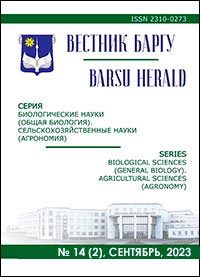KEELED GARLIC (ALLIUM CARINATUM L., AMARYLLIDACEAE) —NEW ALIEN SPECIES OF GARLIC FOR BELARUSIAN FLORA
Keywords:
Amaryllidaceae; Allium carinatum; keeled garlic; new locality; distribution; flora; BelarusAbstract
Mountain Garlic (Allium carinatum L., Amaryllidaceae J. St.-Hil.) is indicated for the first time as an
established alien species for the Belarusian flora. According to the own herbarium data spontaneous growth of species was confirmed in the northern part of Belarus near the railway station Zyabki (Glubokoe district, Vitebsk region).
Newly discovered population belongs to the type ssp. carinatum, which has viviparous bulbs in the inflorescence. This
species has been often confused with morphologically similar A. oleraceum L., which is widespread all over the
territory of Belarus. From the later species A. carinatum easily differs by the length of the stamens, that are exceeding
(rather than equal) the perianth. Brief information about the nomenclature, short history of learning in Belarus,
phytocenology, distribution, ecological and biological features, diagnostic differences from morphologically similar
species of section Codonoprasum are given.
According to the literature, A. carinatum has been indicated for Belarus since the end of the 18th century for
the environs of the Grodno city, and the former Minsk and Mogilev provinces. The lack of documentary confirmation
of this information was the main reason for the lack of this species in the latest floristic literature. Within the total
natural area A. carinatum is heterogeneous and represented by two subspecies. The more widespread typical ssp.
carinatum was previously (since the early 1940s) cultivated in Belarus as an ornamental, medicinal and food plant.
The second ssp. pulchellum is occasionally cultivated as an ornamental plant (in Belarus since the late 1940s). Both
subspecies in Belarus have never been recorded outside the culture.
In Belarus A. carinatum was collected for the first time in 2004 (correctly identified in 2019) as a well
established alien outside of the eastern border of its natural area. In his new locality (as in other synanthropic parts of
its area) A. carinatum has grown in steppe-like plant communities along the railway. New record significantly clarifies
the total distribution of A. carinatum in Eastern Europe.
Fig. 2. Ref.: 33 titles.
Downloads
Published
Issue
Section
License
Copyright (c) 2023 Вестник БарГУ Серия "Биологические науки. Сельскохозяйственные науки"
Это произведение доступно по лицензии Creative Commons «Attribution-NonCommercial» («Атрибуция — Некоммерческое использование») 4.0 Всемирная.
Авторы сохраняют за собой право заключать определенные договорные соглашения, касающиеся неисключительного распространения опубликованной версии работы (например, размещать ее в институциональном репозитории, публикация в книге) со ссылкой на ее первоначальную публикацию в этом журнале.





